You need to provide connectivity to storage1. The solution must meet the PaaS networking requirements and the business requirements.
What should you include in the solution?
You need to provide access to storage2. The solution must meet the PaaS networking requirements and the business requirements.
Which connectivity method should you use?
You need to prepare Vnet1 for the deployment of an ExpressRoute gateway. The solution must meet the hybrid connectivity requirements and the business requirements.
Which three actions should you perform in sequence for Vnet1? To answer, move the appropriate actions from the list of actions to the answer area and arrange them in the correct order.

You ate configuring the DNS forwarding luleset for DNSR1
You need to configure the destination IP address for azure.proseware.com and for corp.proseware.com. The solution must meet the general requirements.
Which IP addiesses should you configure for each namespace? To answer, select the appropriate options in the answer area.
NOTE: Each correct selection is worth one point.

You need to implement a P2S VPN for the users in the branch office. The solution must meet the hybrid networking requirements.
What should you do? To answer, select the appropriate options in the answer area.
NOTE: Each correct selection is worth one point.

You need to implement outbound connectivity for VMScaleSet1. The solution must meet the virtual networking requirements and the business requirements.
Which three actions should you perform in sequence? To answer, move the appropriate actions from the list of actions to the answer area and arrange them in the correct order.
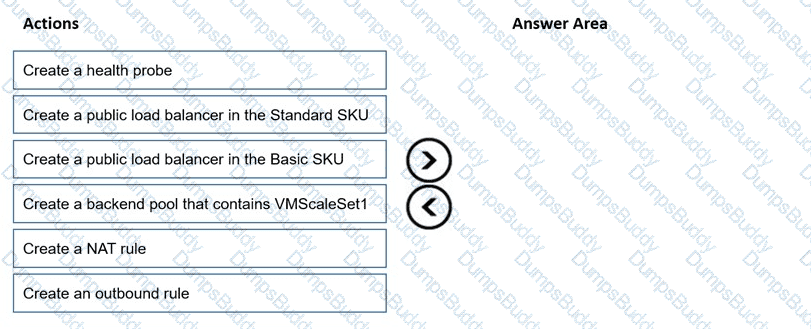
You need to implement name resolution for the cloud.liwareinc.com. The solution must meet the networking requirements.
What should you do? To answer, select the appropriate options in the answer area.
NOTE: Each correct selection is worth one point.

You have the resources shown in the following table.

From the Microsoft Entra admin center, you register the Azure VPN application as an enterprise application.
You need to enable Microsoft Entra authentication for the P2S VPN connections. The solution must meet the following requirements;
• Ensure that only the members of Group1 can establish VPN connections to VPNGW1.
• Ensure that only the members of Group2 can establish VPN connections to VPNGW2.
In which order should you perform the actions? To answer, move all actions from the list of actions to the answer area and arrange them in the correct order.

You have an on-premises datacenter.
You have an Azure subscription that contains 10 virtual machines and a virtual network named VNe1l in the East US Azure region. The virtual machines are connected to VNet1 and replicate across three availability zones.
You need to connect the datacenter to VNetl1by using ExpressRoute. The solution must meet the following requirements:
• Maintain connectivity to the virtual machines if two availability zones fail.
• Support 1000-Mbps connections-
What should you include in the solution? To answer, select the appropriate options in the answer area. NOTE: Each correct selection is worth one point.
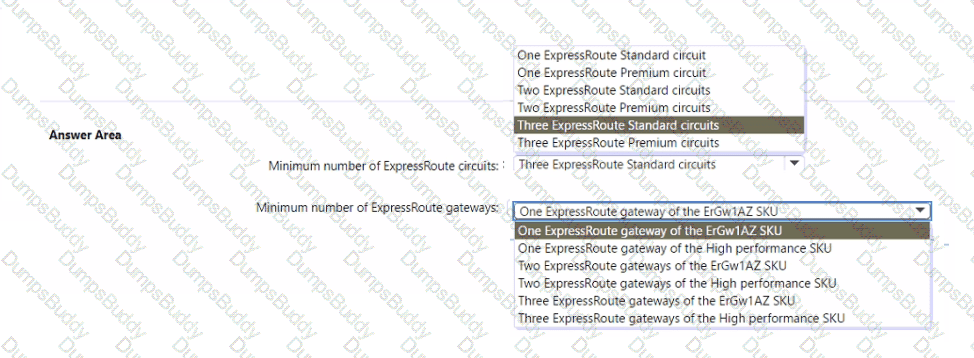
You have an Azure subscription that contains an Azure Firewall Premium policy named FWP1.
To FWP1, you plan to add the rule collections shown in the following table.
Which priority should you assign to each rule collection? To answer, drag the appropriate priority values to the correct rule collections- Each value may be used once, more than once, or not at all. You may need to drag the split bar between panes or scroll to view content.
NOTE: Each correct selection is worth one point.

You have an Azure subscription that contains the resources shown in the following table.

Subshell contains Three virtual machines that host an app named App1. App1 is accessed by using the SFTP protocol.
From NSG1. you configure an inbound security rule named Rule2 that allows inbound SFTP connections to ASG1.
You need to ensure that the inbound SFTP connections are managed by using ASG1. The solution must minimize administrative effort.
What should you do?
You need to recommend a configuration for the ExpressRoute connection from the Boston datacenter. The solution must meet the hybrid networking requirements and business requirements.
What should you recommend? To answer, select the appropriate options in the answer area.
NOTE: Each correct selection is worth one point.

You need to connect Vnet2 and Vnet3. The solution must meet the virtual networking requirements and the business requirements.
Which two actions should you include in the solution? Each correct answer presents part of the solution.
NOTE: Each correct selection is worth one point.
You need to configure the default route in Vnet2 and Vnet3. The solution must meet the virtual networking requirements.
What should you use to configure the default route?
You need to restrict traffic from VMScaleSet1 to VMScaleSet2. The solution must meet the virtual networking requirements.
What is the minimum number of custom NSG rules and NSG assignments required? To answer, select the appropriate options in the answer area.
NOTE: Each correct selection is worth one point.
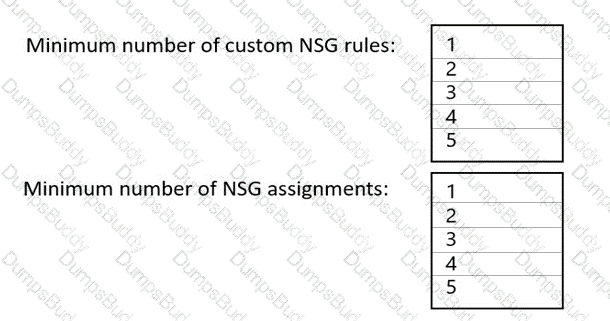
You have an Azure subscription that contains an Azure VPN gateway named GW1. GW1 provides Point-to Site (P2S) VPN connectivity.
Users connect to GW1 from a Windows 11 device by using an SSTP connection.
You need to ensure that the P2S VPN connections support Microsoft Entra authentication.
Which three actions should you perform in sequence? To answer, move the appropriate actions from the list of actions to the answer area and arrange them in the correct order.
NOTE: More than one order of answer choices is correct. You will receive credit for and of the correct orders you select.

Your on-premises network contains a VPN device.
You have an Azure subscription that contains a virtual network and a virtual network gateway.
You need to create a Site-to-Site VPN connection that has a custom cryptographic policy.
How should you complete the PowerShell script? To answer, select the appropriate options in the answer area.
NOTE: Each correct selection is worth one point.

You have an Azure subscription that contains a resource group named RG1 and a virtual network named VNet1 You need to deploy Azure Firewall to RG1. The solution must minimize administrative effort What should you do first?
You have two Azure virtual networks named Hub1 and Spoke1. Hub1 connects to an on-premises network by using a Site-to-Site VPN connection.
You are implementing peering between Hub1 and Spoke1.
You need to ensure that a virtual machine connected to Spoke1 can connect to the on-premises network through Hub1.
How should you complete the PowerShell script? To answer, drag the appropriate values to the correct targets. Each value may be used once, more than once, or not at all. You may need to drag the split bar between panes or scroll to view content.
NOTE: Each correct selection is worth one point.

You have the on-premises networks shown in the following table.

You have an Azure subscription that contains an Azure virtual WAN named VWAN1 and a virtual network named VNet1 VWAN1 is connected to the on-premises networks and VNet1 in a full mesh topology. The virtual hub routing preference for VWAN1 is AS Path.
You need to route traffic from VNet1 to 10.61.1.5.
Which path will be used?
Your company has five offices. Each office has a firewall device and a local internet connection. The offices connect to a third-party SD-WAN.
You have an Azure subscription that contains a virtual network named Vnet1. Vnet1 contains a virtual network gateway named Gateway1. Each office connects to Gateway1 by using a Site-to-Site VPN connection.
You need to replace the third-party SD-WAN with an Azure Virtual WAN. What should you include in the solution?
You have an Azure subscription that contains an instance of Azure Firewall Standard named AzFW1. You plan to enable the following:
• TLS inspection
• Threat intelligence
• A network intrusion detection and prevention system (IDPS)
What can you enable by using AzFW1?
You have an Azure subscription that contains an Azure Front Door Premium profile named AFD1 and an Azure Web Application Firewall (WAF) policy named WAF1. AFD1 is associated with WAF1.
You need to configure a rate limit for incoming requests to AFD1.
Solution: You add a rule to the rule set of AFD1.
Does this meet the goal?
Note: This question is part of a series of questions that present the same scenario. Each question in the series contains a unique solution that might meet the stated goals. Some question sets might have more than one correct solution, while others might not have a correct solution.
After you answer a question in this section, you will NOT be able to return to it as a result, these questions will not appear in the review screen.
You have an Azure subscription that contains an Azure Front Door Premium profile named AFD1 and an Azure Web Application Firewall (WAF) policy named WAF1. AFD1 is associated with WAF1.
You need to configure a rate limit for incoming requests to AFD1.
Solution: You configure a managed rule for WAF1.
Does this meet the goal?
You have an Azure subscription that contains a virtual network named VNet1. VNet1 contains the resources shown in the following table.

You need to publish App1 by using AG1 and a URL of https://app1.contoso.com. The solution must meet the following requirements:
• TLS connections must terminate on AG1.
• Minimize the number of targets in the backend pool of AG1.
• Minimize the number of deployed copies of the SSL certificate of App1.
How many locations should you import to the certificate, and how many targets should you add to the backend pool of AG1? To answer, select the appropriate options in the answer area.
NOTE: Each correct selection is worth one point.

You have an Azure subscription that contains an Azure App Service web app named WebApp1 and an Azure Front Door profile named FDProfile1 FDProfile1 forwards requests addressed to https://www.contoso.com to WebApp1.
You need to ensure that only requests addressed to https://www.contoso.com/users/are forwarded to WebApp1.
What should you modify in FDProfile1?
You have an Azure subscription that contains a virtual network named VNet1 and the virtual machines shown in the following table.

All the virtual machines are connected to VNet1.
You need to ensure that the applications hosted on the virtual machines can be accessed from the internet. The solution must ensure that the virtual machines share a single public IP address
What should you use?
You have the network topology shown in the Topology exhibit. (Click the Topology tab.)

You have the Azure firewall shown in the Firewall 1 exhibit. (Click the Firewall tab.)
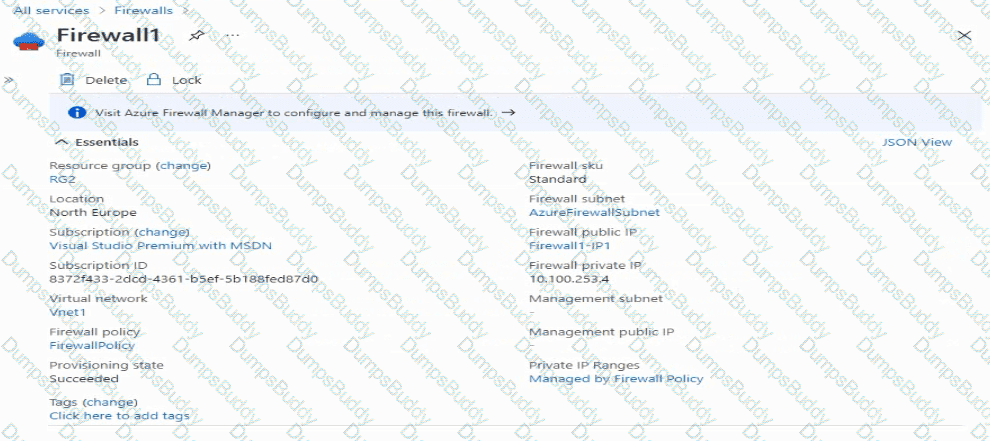
You have the route table shown in the RouteTable1 exhibit. (Click the RouteTable1 tab.)
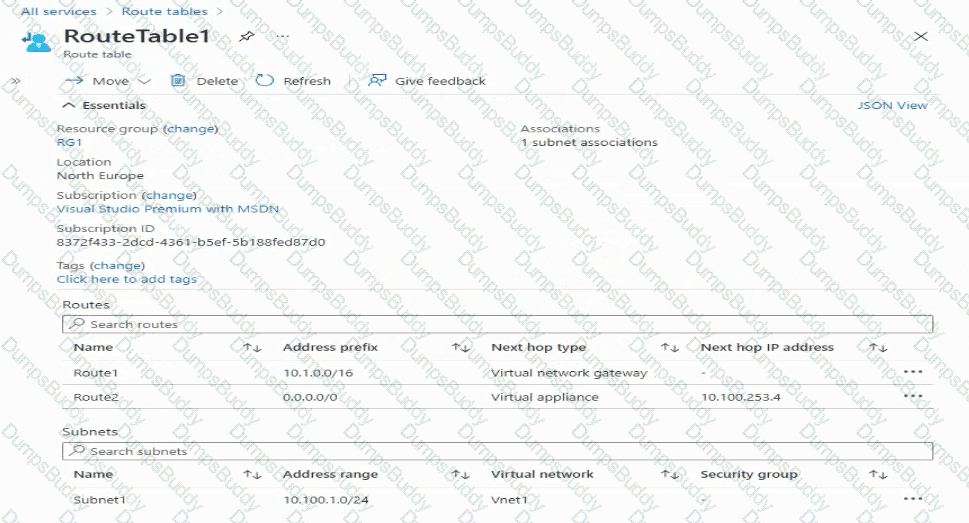
For each of the following statements, select Yes if the statement is true. Otherwise, select No.
NOTE: Each correct selection is worth one point.

You need to deploy Azure Virtual Network Manager. The solution must support the planned changes and meet the connectivity requirements.
Which four actions should you perform in sequence? To answer, move the appropriate actions from the list of actions to the answer area and arrange them in the correct order.
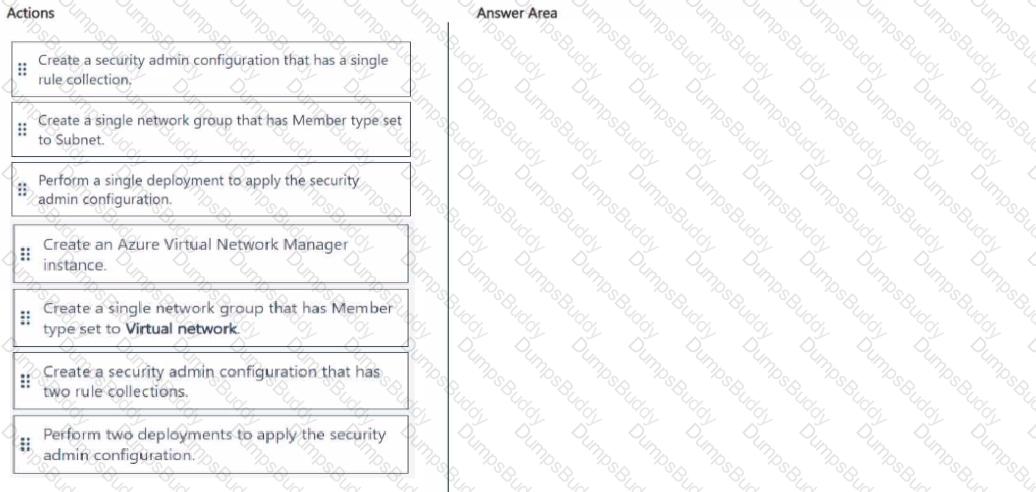
Note: This question is part of a series of questions that present the same scenario. Each question in the series contains a unique solution that might meet the stated goals- Some question sets might have more than one correct solution, while others might not have a correct solution.
After you answer a question in this section, you will NOT be able to return to it. As a result, these questions will not appear in the review screen.
You have on Azure subscription that contains an Azure Virtual WAN named VWAN1. VWAN1 contains a hub named Hub1.
Hub! has a security status of Unsecured.
You need to ensure that the security status of Hub1 is marked as Secured.
Solution: You implement Azure NAT Gateway.
Does this meet the requirement?
Task 6
You need to ensure that all hosts deployed to subnet3-2 connect to the internet by using the same static public IP address. The solution must minimize administrative effort when adding hosts to the subnet.
Task 10
You plan to deploy several virtual machines to subnet1-2.
You need to prevent all Azure hosts outside of subnetl-2 from connecting to TCP port 5585 on hosts on subnet1-2. The solution must minimize administrative effort.
Task 7
You plan to deploy 100 virtual machines to subnet4-1. The virtual machines will NOT be assigned a public IP address. The virtual machines will call the same API. which is hosted by a third party. The virtual machines will make more than 10,000 calls per minute to the API.
You need to minimize the risk of SNAT port exhaustion. The solution must minimize administrative effort.
Task 1
You plan to deploy a firewall to subnetl-2. The firewall will have an IP address of 10.1.2.4.
You need to ensure that traffic from subnetl-1 to the IP address range of 192.168.10.0/24 is routed through the firewall that will be deployed to subnetl-2. The solution must be achieved without using dynamic routing protocols.
Task 2
You need to create an Azure Firewall instance named FW1 that meets the following requirements:
• Has an IP address from the address range of 10.1.255.0/24
• Uses a new Premium firewall policy named FW-pohcy1
• Routes traffic directly to the internet
Task 10
You need to configure VNET1 to log all events and metrics. The solution must ensure that you can query the events and metrics directly from the Azure portal by using KQL.
Task 5
You need to ensure that requests for wwwjelecloud.com from any of your Azure virtual networks resolve to frontdoor1.azurefd.net.
Task 3
You plan to implement an Azure application gateway in the East US Azure region. The application gateway will have Web Application Firewall (WAF) enabled.
You need to create a policy that can be linked to the planned application gateway. The policy must block connections from IP addresses in the 131.107.150.0/24 range. You do NOT need to provision the application gateway to complete this task.
Which virtual machines can VM1 and VM4 ping successfully? To answer, select the appropriate options in the answer area.
NOTE: Each correct selection is worth one point.
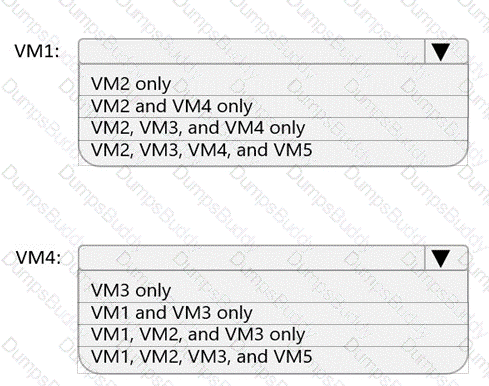
In which NSGs can you use ASG1 and to which virtual machine network interfaces can you associate ASG1? To answer, select the appropriate options in the answer area.
NOTE: Each correct selection is worth one point.

For each of the following statements, select Yes if the statement is true. Otherwise, select No.
NOTE: Each correct selection is worth one point.

You are implementing the Virtual network requirements for Vnet6.
What is the minimum number of subnets and service endpoints you should create? To answer, select the appropriate options in the answer area.
NOTE: Each correct selection is worth one point.

You need to meet the network security requirements for the NSG flow logs.
Which type of resource do you need, and how many instances should you create? To answer, select the appropriate options in the answer area.
NOTE: Each correct selection is worth one point.

You need to configure GW1 to meet the network security requirements for the P2S VPN users.
Which Tunnel type should you select in the Point-to-site configuration settings of GW1?
For each of the following statements, select Yes if the statement is true. Otherwise, select No.
NOTE: Each correct selection is worth one point.

What should you implement to meet the virtual network requirements for the virtual machines that connect to Vnet4 and Vnet5?
You are implementing the virtual network requirements for VM Analyze.
What should you include in a custom route that is linked to Subnet2? To answer, select the appropriate options in the answer area.
NOTE: Each correct selection is worth one point.
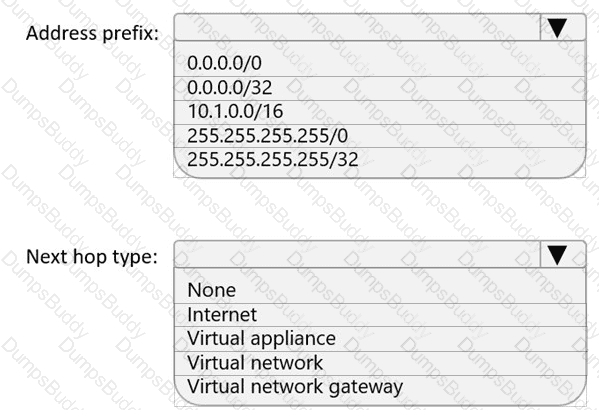
You create NSG10 and NSG11 to meet the network security requirements.
For each of the following statements, select Yes it the statement is true. Otherwise, select No.
NOTE: Each correct selection is worth one point.

You need to configure APPGW1 to support end-to-end encryption. The solution must meet the security requirements. What should you do?
You need to configure connectivity between NYCNet and SFONet. The solution must meet the connectivity requirements. What should you do? To answer, select the appropriate options in the answer area. NOTE: Each correct selection is worth one point.

You need to manage connectivity from NYCNet to the Azure services that use private endpoints. The solution must meet the security requirements. What should you do first?